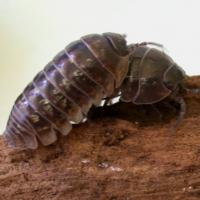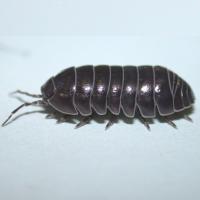Diagnosing slaters in crops
Slaters have only recently become a problem in high rainfall crops sown into dense stubble. Slaters, also known as woodlice, sowbugs and pill bugs, are crustaceans related to crabs, lobsters and prawns but are adapted to living on land.
What to look for
- Bare areas, seedling stumps, or chewed and shredded seedlings, usually in patches and in areas with higher stubble or pasture residues.
Paddock
- Slater feeding on plants causes an uneven rasping-type damage that can appear similar to slug and snail damage.
They can chew the tops of emerging cotyledons or leaves of crop seedlings, leaving only the seedling stumps.
Plant
- Slaters are easily found under dense stubble. They have a hard skeleton on the outside of their bodies, seven pairs of jointed legs, and two pairs of antennae.
Insect Adult
What else could it be
| Condition | Similarities | Differences |
|---|---|---|
| Diagnosing European earwig | Shredded plants, seedling death, worse under heavy stubble | Slaters are easily found under stubble in vicinity of crop damage. |
| Diagnosing slugs in crops | Similar plant damage, shredded plants, seedling stumps. | Slater damage is worse near heavy retained stubble under which they will be easily found. |
| Diagnosing snails in crops | Similar plant damage. | Slater damage is worse near heavy retained stubble under which they will be easily found. |
|
Caterpillars or beetles
|
Chewing damage can be similar to other pests | Slaters are readily found in the vicinity of the damage |
Where did it come from?
- Slaters feed on decaying vegetation and associated fungi, as well as on dead animal matter such as insects. They rarely eat living plants. Slaters need damp conditions and will die if exposed to open and dry situations. They tend to be active at night when the risk of dehydration is low. Female slaters keep their eggs in a pouch until the young hatch. Hatchlings then leave the parent and are completely independent. Slaters grow through a series of moults in which the outer rigid skeleton is shed, allowing growth to the next larger stage and finally to adult stage.
Management strategies

Stubble management
- Reducing stubble is an effective strategy to reduce slater numbers. Some growers have successfully reduced slaters ahead of canola crops through burning crop residues.
- Treat areas supporting high slater populations with snail baits containing methiocarb or iron EDTA baits . Granular products containing bifenthrin are also registered to control slaters.
Economic and financial considerations
To assist in assessing the economic risk and financial costs associated with various treatment strategies go to MyEconomicTool
There may be other economic and financial implications that need to be considered when choosing a management option. These may include:
Pre-crop- Understand the risk of slaters being present and potential yield losses associated with slater feeding damage.
- Assess the costs and benefits of taking preventative action such as destroying stubble versus baiting.
- There are no insecticide sprays registered to control slaters, baits have some efficacy but prevention is the key part of control.
- Compare the costs, benefits and risks of re-sowing against doing nothing.
- Consider using integrated pest management system.
View these economic considerations in more detail.
How can it be monitored?
- Slaters rarely damage crops. Crop damage occurs when slater numbers build-up. This happens when there have been a few wet summers in a row combined with heavy stubble loads on paddocks. If slaters are easily seen, that is at least 3 per 10 square centimeters, this suggest numbers are building up and control measures should be put in place before canola is seeded into the paddock.
Further information
Page last updated: Tuesday, 20 January 2015 - 10:48am



